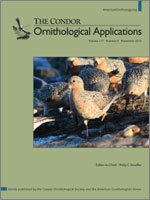The Robertson and Woolfenden Florida Bird Species: An Annotated List by Jon S. Greenlaw, Bill Pranty, and Reed Bowman. 2014. FOS Special Publication 8. Florida Ornithological Society, Gainesville, FL, USA. 435 pages + vii. $24 (paperback).
Florida holds a justly famous place of distinction for its wealth of birdlife, and this book provides a much needed update to the original Florida Birds Species: An Annotated List (Robertson and Woolfenden 1992), which described the occurrence and distribution of bird species reported in Florida through December 1991. In the intervening 21 years, much has changed in Florida's avifauna. The original work covered 461 verified species and contained three Appendices: Unverified Stragglers (75 species), Probably Unestablished Exotics (16 species), and Unestablished Exotics (119 species). Thus, the original work discussed a total of 671 species. The new text documents 514 species shown in the Main List: Accepted Birds of Florida. The authors created a slightly different division with their two Appendices (under the general title Non-accepted Birds of Florida): Non-accepted Potential Natural Vagrants (90 species) and Non-established Exotics (211 species). The new book documents a total of 815 species, an increase of 144 species over the original text, and is greatly expanded from 260 pages in the original to 435 pages in the current edition.
As stated in the title, this is an annotated list of the birds that occur in Florida. Its scope is limited to occurrence and seasonal distribution, with short species accounts; the authors have not attempted an exhaustive treatment of each species. Readers searching for more detail can refer to Arthur H. Howell's Florida Bird Life (1932) or Alexander Sprunt, Jr.'s revision of the same title (1954), and The Birdlife of Florida by Henry M. Stevenson and Bruce H. Anderson (1994). That said, the inclusion of specimen records and documentation of both the published photographs and additional photographic records of each species bring this verifiable information together in one easy-to-reference location. The Introduction includes excellent essays on the patterns of distribution, an interesting comparison of this work to other leading summaries of the state's avifauna, and an important overview of the composition of Florida birdlife and recent changes in occurrence.
There are significant improvements over the original edition. The species accounts are often more extensive, with updated information such as the change in distribution of the Smooth-billed Ani (Crotophaga ani); new information based on recently researched specimens, such as the discovery of a Common Greenshank (Tringa nebularia) from Tampa from 1882 in a collection at The Ohio State University Museum of Biological Diversity; and, of course, new species that have recently occurred in Florida, such as the Variegated Flycatcher (Empidonomus varius) in 2013.
The valuable Appendix on “Non-established Exotics” covers a remarkable 211 species. It includes an excellent essay on the “History of Bird Introductions into the United States, Primarily Florida” that provides a useful overview of this increasingly important component of Florida birdlife. There is also an essay on the “Breeding Status of Exotic Birds in Florida.” Exotic species have become an ever increasing component of the state's avifauna, and this work provides the most up-to-date information available on these species.
In addition to the essays, there are several very useful tables, including one titled “Estimated population size of each exotic species known or suspected to be breeding in Florida, 2008–12” that provides a unique resource for important information on breeding exotic species and a vital baseline for gauging future changes in this component of Florida's avifauna. There is also an additional map delineating exotic species richness by county that graphically demonstrates the preponderance of the diversity of exotic species in southeast Florida. This includes an amazing 142 exotic species documented in Miami-Dade County alone.
The main section of this book provides the most current information on the accepted birds of Florida in summaries that are concise, clear, and consistent. For this information alone, the book would be a worthwhile contribution. However, the excellent sections on the exotic species in the state and the various essays and tables combine to make it a must-have for all students of the avifauna of Florida. While highly recommended for all those interested in the state's rich birdlife, this book is also valuable for its contribution to the understanding of the expansion of exotic species in the United States. Libraries, colleges and universities, ornithologists, and birders will all find this a valuable addition.






